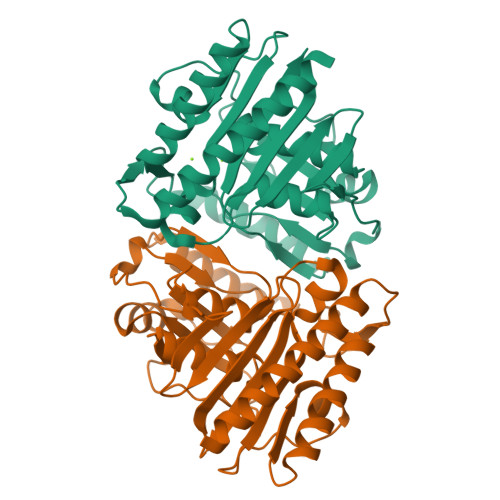High-resolution structure of myo-inositol monophosphatase, the putative target of lithium therapy.
Gill, R., Mohammed, F., Badyal, R., Coates, L., Erskine, P., Thompson, D., Cooper, J., Gore, M., Wood, S.(2005) Acta Crystallogr D Biol Crystallogr 61: 545-555
- PubMed: 15858264
- DOI: https://doi.org/10.1107/S0907444905004038
- Primary Citation of Related Structures:
2BJI - PubMed Abstract:
Inositol monophosphatase is a key enzyme of the phosphatidylinositol signalling pathway and the putative target of the mood-stabilizing drug lithium. The crystal structure of bovine inositol monophosphatase has been determined at 1.4 A resolution in complex with the physiological magnesium ion ligands. Three magnesium ions are octahedrally coordinated at the active site of each of the two subunits of the inositol monophosphatase dimer and a detailed three-metal mechanism is proposed. Ligands to the three metals include the side chains of Glu70, Asp90, Asp93 and Asp220, the backbone carbonyl group of Ile92 and several solvent molecules, including the proposed nucleophilic water molecule (W1) ligated by both Mg-1 and Mg-3. Modelling of the phosphate moiety of inositol monophosphate to superpose the axial phosphate O atoms onto three active-site water molecules orientates the phosphoester bond for in-line attack by the nucleophilic water which is activated by Thr95. Modelling of the pentacoordinate transition state suggests that the 6-OH group of the inositol moiety stabilizes the developing negative charge by hydrogen bonding to a phosphate O atom. Modelling of the post-reaction complex suggests a role for a second water molecule (W2) ligated by Mg-2 and Asp220 in protonating the departing inositolate. This second water molecule is absent in related structures in which lithium is bound at site 2, providing a rationale for enzyme inhibition by this simple monovalent cation. The higher resolution structural information on the active site of inositol monophosphatase will facilitate the design of substrate-based inhibitors and aid in the development of better therapeutic agents for bipolar disorder (manic depression).
Organizational Affiliation:
Biomolecular Sciences Group, School of Biological Sciences, University of Southampton, Bassett Crescent East, Southampton SO16 7PX, England.



















